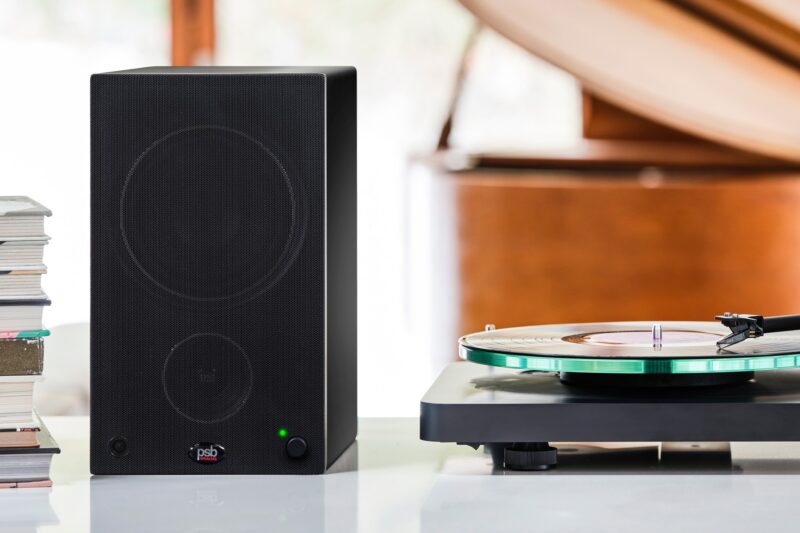Building A Astounding Hi-Fi System Around The Affordable PSB Alpha AM5 Powered Bookshelf Speakers!
When you’re talking about setting up a Hi-Fi System for less than 1000 dollars, a set of good powered bookshelf speakers can go a long way. If designed well, you get a quality set of speakers, a decent amplifier, and a serviceable preamp, all wrapped in a tidy little package. In some cases, you even get a source built-in, usually in the form of a Bluetooth receiver, but built-in Wi-Fi streamers are available as well.
A brief note: The system I’m proposing will be well-rounded and able to play any music. Highs will be relatively refined, and bass will be plentiful, but this will not be a full-range system. Midrange will be full and natural, providing you with a very engaging performance.
Also, keep in mind that this system will be at its best in an averaged sized room (up to 250-300 sq ft.). Any larger than that, I recommend you get floorstanding speakers, which will probably take you well above the $1000 budget.
With a budget of $1000, I would build my powered bookshelf system around the recently released PSB Alpha AM5 Powered Speakers, which sell for a very reasonable price of $599. These speakers were designed from top to bottom by Paul Barton, the founder of PSB speakers and a legend in speaker design.

I had the opportunity to speak with him about these speakers when they first came out (more about that in my review). He was excited at the prospect of designing a complete system based on one of his most popular affordable designs, the PSB Alpha P5 (check out our review), which we reviewed a while back. (It also won the Product of the Year Award from Stereophile)
He packed the AM5 with critically acclaimed Class-D amp technology from sister company NAD along with digital signal processing to optimize sound for the enclosure. This results in a very refined-sounding speaker that sells at a great price.
Besides quality components, the PSB Alpha AM5 also has a decent complement of inputs, including an aux input, optical input, USB input, and even a phono input. If you need more low end, it has a sub out that will work superbly with the PSB Alpha S8 Sub ($449). These are the connections you need to build a nice system.
By the way, the AM5 system comes with a remote control, which allows you to change volume, switch inputs, adjust bass or treble, activate the sub out, or select between sound modes (dialogue, soundstage, both).

Source: Analog or Digital?
Where you go from here depends on your listening habits. If you’re an analog audiophile, you can grab a decent budget turntable like the Pro-Ject T1 Turntable (Piano Black) ($349), which will start you off right with a nice solid MDF plinth, heavy glass platter, and a serviceable Ortofon OM5e cart. If you get the upgrade bug, that cart is easily upgradable to a well-respected Ortofon 2M Red ($99) or 2M Blue cartridge ($236).
If you’re the digital type, then you have many options. First, the AM5’s built-in Bluetooth receiver sounds great, especially if you have a smartphone with aptX. If you want an upgrade in sound plus flexibility, then you can go with a Wi-Fi streamer like the Andover Audio Songbird, which provides great sound quality for just $129.

The Songbird is easy to hook up. Just plug it into the AM5’s optical input with a Toslink cable, download the free remote control app (Android or iOS) and follow the onscreen prompts. Once connected, you can play music from many online music services like TIDAL or Spotify, or you can even play music from a DLNA network drive. For the Apple folks, you can send music over via Apple Airplay. If you use Roon, you can use Apple Airplay to send music from Roon to the streamer.
If you’re a traditionalist and still listen to CDs, you can pick up the Cambridge Audio AXC35, a quality CD player that costs only $349. While the drawer can be a tad bit loud compared to costlier models, you will forget all about that when you hear the beautiful Redbook CD sound, it emits from your system. That’s courtesy of the Wolfson DAC inside, which is known for its smooth, natural sound.

If you have a laptop, that opens up the third option since the Alpha AM5 has a mini USB connection on the back. All you need is music software like Roon or Audirvana (my two favorites), or even TIDAL desktop software, and then you can play music right from the laptop into the speakers. Both software packages have apps so you can control playback from a smartphone which is pretty cool.
Accessories and Add-Ons
Now that you have your speakers and source squared away, you’ll need cables to connect your sources. I recommend some quality cables from Audioquest.
For the CD player, you can grab a 3.5mm to RCA interconnect like the Audioquest Evergreen Audio Interconnect ($49.95) and connect it to the 3.5mm Aux port on the back of the speakers.
For the streamer, you can go with an AudioQuest Forest Toslink Fiber Optic Digital Audio Cable, which is also $49.95. It will go from the Andover Audio Songbird’s digital output to the digital input on the speakers.
If you’re using a laptop, then the AudioQuest Pearl 1.5 m Micro-USB Cable ($49.95) will be the one you need.
For the turntable, you can save a few bucks since the Pro-ject T1 has a pre-connected cable. You plug the cable into the phono input on the back of the speakers.

If you’re not so sure about spending so much on cables upfront, AmazonBasics also has a full selection of similar cables for less cash.
Once you get your cables, then some add-ons will enhance your system. One is a decent pair of speaker stands. These will let you get the Alpha AM5s out into the room and toe them in towards your listening position for optimum imaging and soundstage.
You could also put them on a sideboard using the included rubber feet as isolation, but in my opinion, they will sound their best on stands like the Monolith 24 Inch Speaker Stands ($55 each). These metal stands are sturdy, plus you can fill them with sand or steel shot for better dampening of vibrations.
If you get the turntable or cd player, these stands will put you over the $1000 target. Still, you can fit them in by going with cheaper AmazonBasic cables and/or going for cheaper stands like the Sanus BF24B 24 Inch Speaker Stands ($49.99 a Pair), which do not have the same isolation properties but will help with speaker placement.

Additional add ons would be the PSB Alpha S8 Sub ($499) and PSB Alpha S10 Sub ($549), which will make this a full-range setup but definitely would bust the $1000 budget. These will be recommended if you crave additional bass. I listen to a lot of jazz, singer-songwriter, and acoustic music, so I rarely use a sub with bookshelf speakers.
So here’s a rundown of the different setups:
w/ Streamer-
PSB Alpha AM5 Powered Speakers ($599)
Andover Audio Songbird ($129)
AudioQuest Forest Toslink Fiber Optic Digital Audio Cable ($49.99)
Monolith 24 Inch Speaker Stands ($54.99 Each)
Total: $888.00
w/ CD Player-
PSB Alpha AM5 Powered Speakers ($599)
Cambridge Audio AXC35 ($349)
Audioquest Evergreen Audio 3.5mm to RCA Interconnect ($49.95)
Total: $997.95
w/ Turntable-
PSB Alpha AM5 Powered Speakers ($599)
Pro-Ject T1 Turntable (Piano Black) ($349)
(Turntable has pre-connected cable)
Total: $948
w/Laptop-Computer-
PSB Alpha AM5 Powered Speakers ($599)
AudioQuest Pearl 1.5 m Micro-USB Cable ($49.95)
Monolith 24 Inch Speaker Stands ($54.99 Each)
Total: $703.94
Add-Ons:
Sanus BF24B 24 Inch Speaker Stands ($49.99)
Monolith – 124794 24 Inch Speaker Stand ($54.99 Each)
PSB Alpha S8 Sub ($499)
PSB Alpha S10 Sub ($549)
The Wrap-Up
So, I hope this little walkthrough will help you negotiate building an affordable high-end audio system based around powered bookshelf speakers. If you have more questions, feel free to drop us a line!
Of course, while this kind of system will simplify things since you don’t have to match an amp to passive speakers, some people consider that a valuable part of the audiophile hobby. When you have separate components, it also gives you more avenues for an upgrade later, which is also advantageous.
For that reason, stay tuned for part two of this post, where we build a $1000 system using a separate amp and speakers.
As an Amazon Associate, Hifitrends.com may earn from qualifying purchases via links placed throughout the site…this helps us keep the website going! Thanks in advance for your help! Prices are subject to change at any time.

I’m an audio writer who started as a young audio salesman/consumer electronics professional back in the late 90s. That’s where I discovered the magic of 2-Channel sound. My thirst for great sound has led me on a delightful music quest that continues today.


Leave a Reply